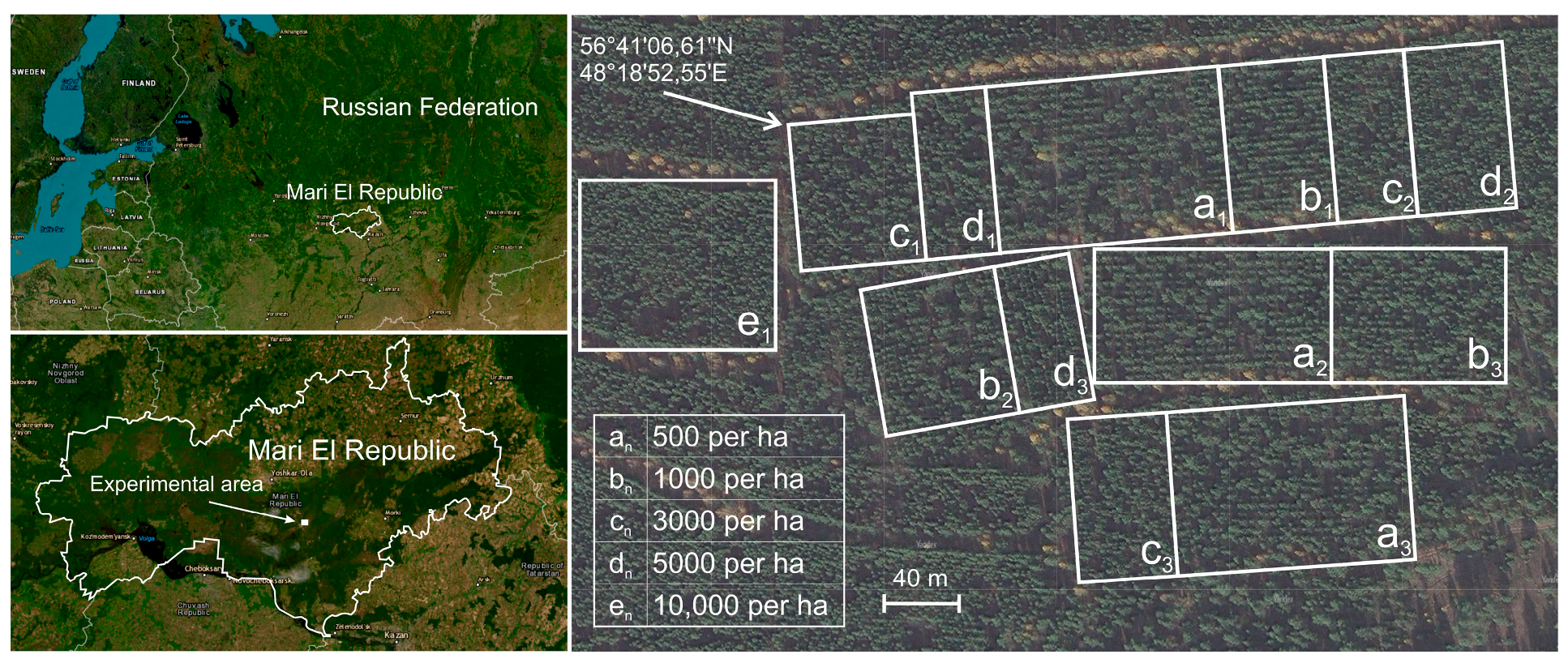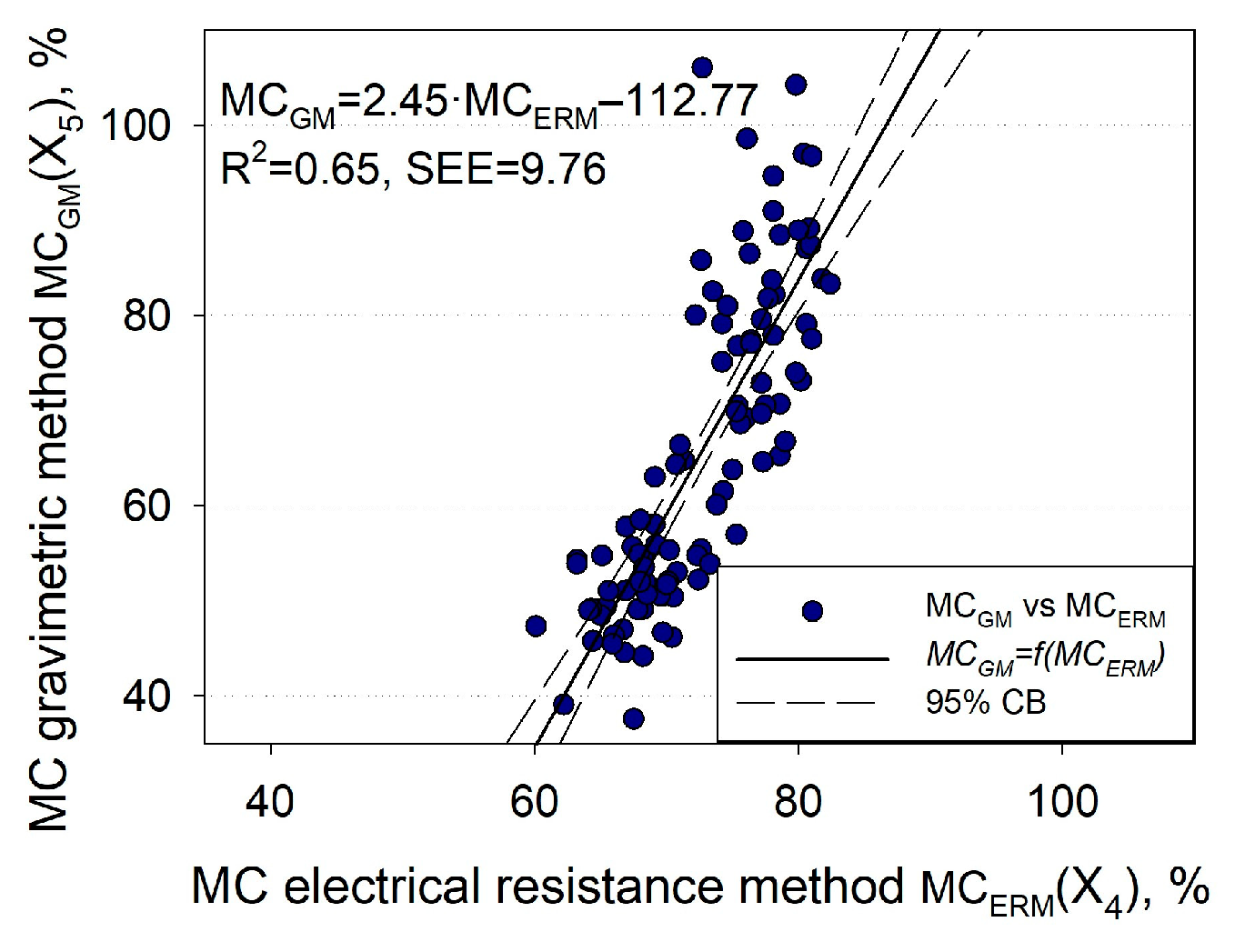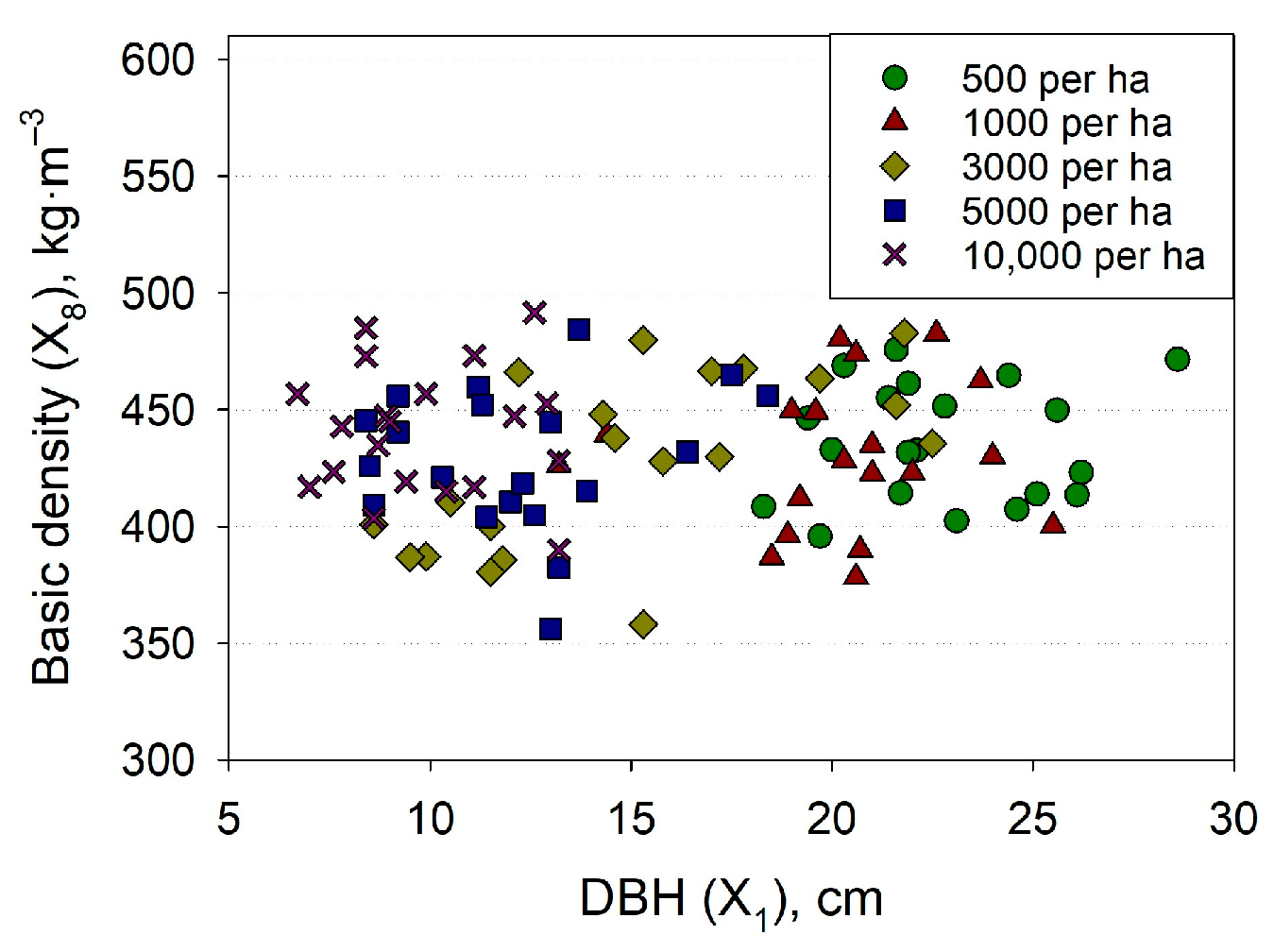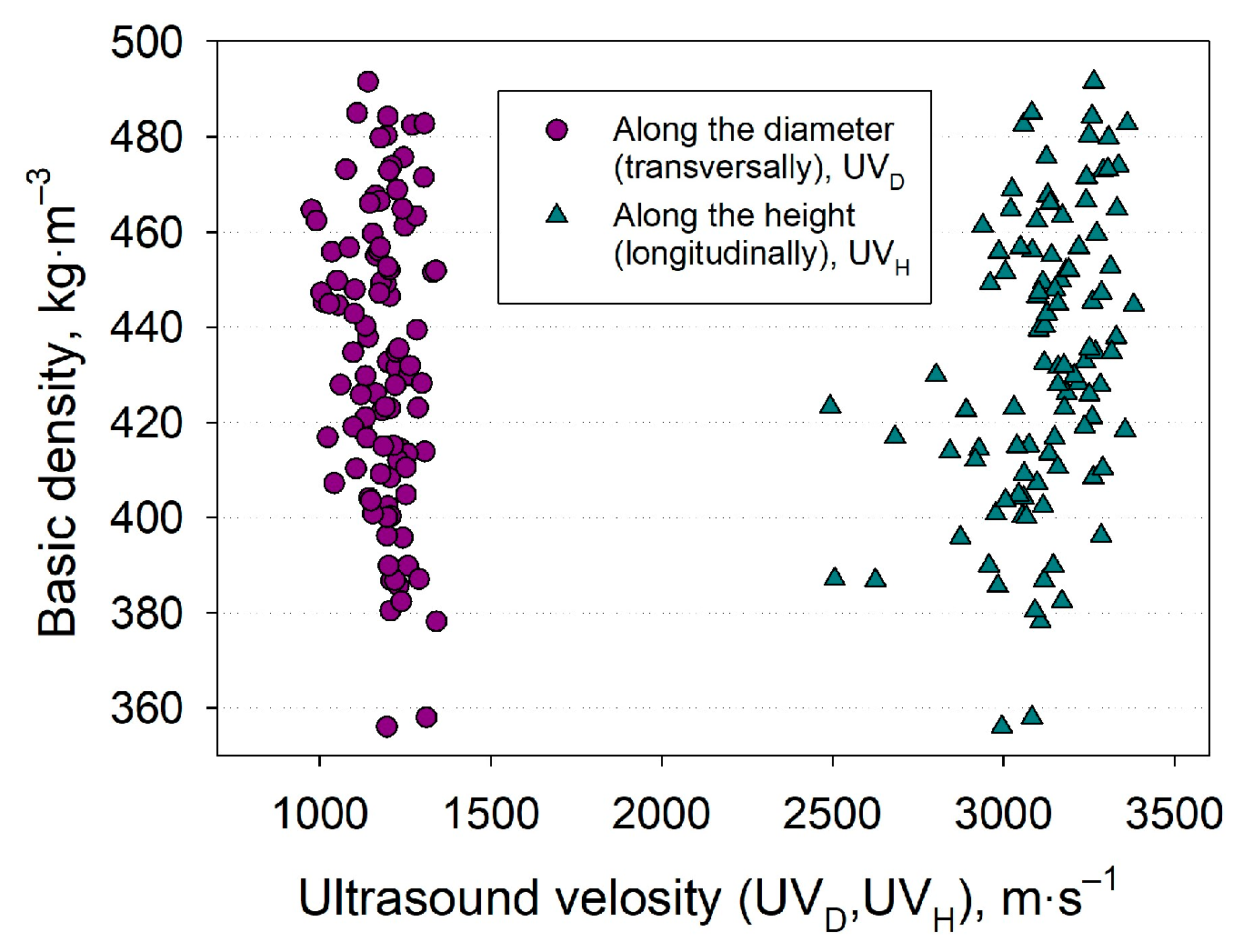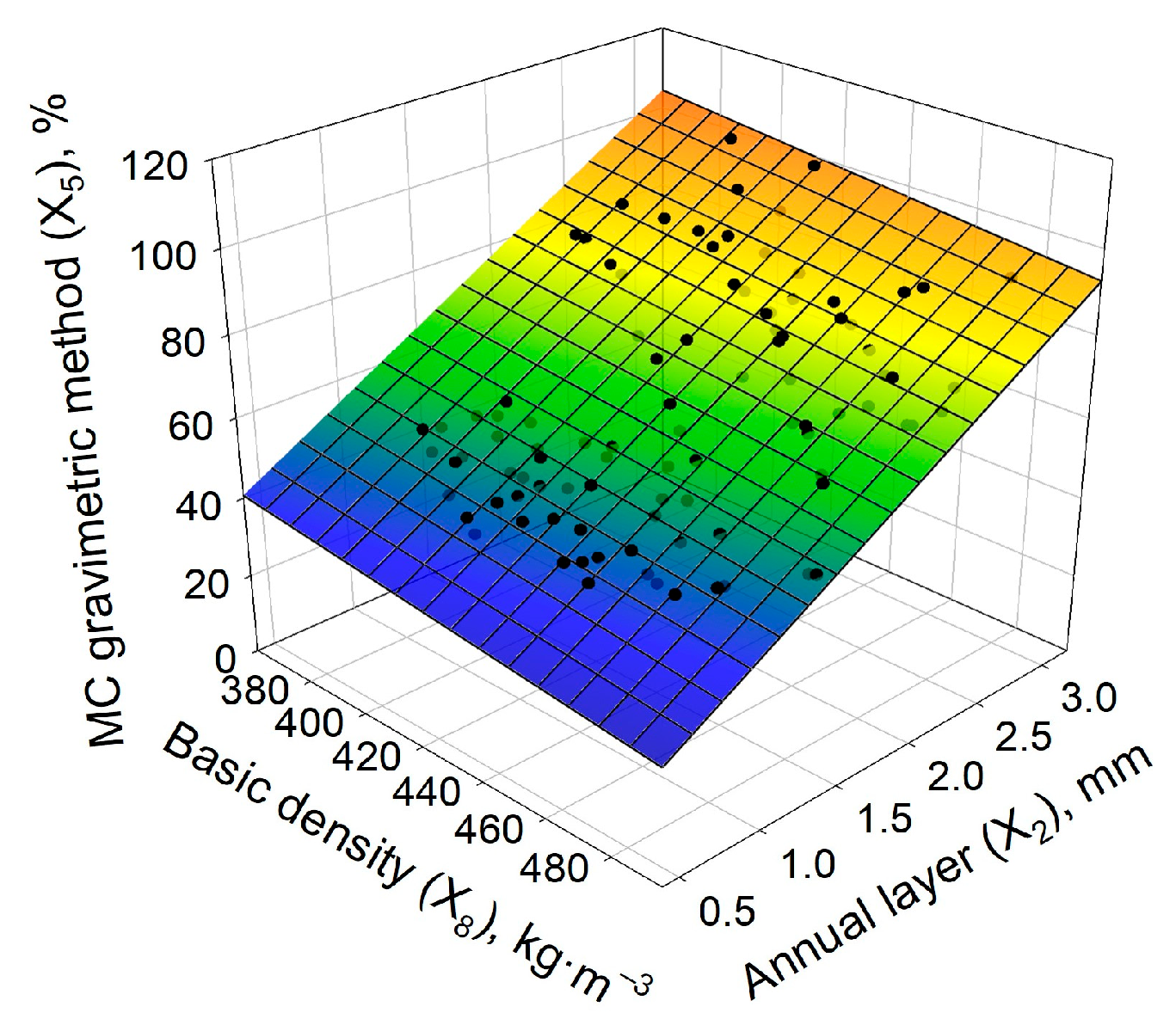1. Introduction
The initial density of forest plantations is one of the key factors determining their productivity, marketability, viability, and environmental protection. It also affects the overall economic efficiency (profitability) of forest cultivation. Research literature contains extensive discussion on the issue of stand density optimisation, which is utterly important from a practical standpoint. The multifaceted nature of the problem and a wide range of possible solutions account for why it has not lost its relevance [
1,
2,
3,
4,
5,
6,
7,
8,
9,
10,
11].
It has been established that there is no relative optimal stand density for the initial and current plantations [
12]. The optimal stand density is determined by the set goal, which can be either increasing complex productivity while accounting for all biological components of forest ecosystems, obtaining wood of the required quality and quantity in the shortest possible time, or enhancing the stability and durability of plantations, their environmental and protective functions, and the appeal for human recreation.
Most researchers aimed to investigate the dynamics of taxation indicators. Studies examining the impact of pine-planting practices and their initial density on the mechanical and physical properties of wood, as well as its technical quality, are limited. The most important parameter of wood is basic density, which also determines the trees’ resistance to icing, wind loads, snowdrifts, and trunk rot. The research findings on this subject are far from conclusive [
8,
13,
14,
15]. This is caused by the variety of forest biogeocenoses, as well as the way in which environmental conditions affect them. Thus, for example, Poluboiarinov and Fedorov [
13] claimed that in the northwest of the European part of Russia, the increased density of Scots pine (
Pinus sylvestris L.) plantations led to a significant reduction in tree height increment (r = −0.62), the width of annual rings (r = −0.95), and wood density (r = −0.58). Nevertheless, it had a negligible impact on the length of the tracheids (r = 0.20) and the proportion of the latewood (r = 0.17). Zhu et al. [
2] noted that with an increase in red pine (
Pinus resinosa Ait.) stand density, the average width of the annual layer decreases (r = −0.90, −0.96), which, according to the authors, is the most accurate parameter to describe the influence of stand density on wood density and anatomical parameters of tracheids. Using the SilviScan, the authors found that with a decrease in the average width of the annual layer, the wood density as a whole increases (r = −0.30), while the density of latewood decreases (r = 0.45) and the density of early wood in the annual layer increases (r = −0.52).
The initial density of
Populus tometosa plantations in China, according to Sang et al. [
7], did not significantly affect the wood’s basic density. Wood density had a weak and positive correlation with poplar growth traits within each planting density. Similar results with no significant effect of initial plantation density on wood’s basic density were presented by Melo et al. [
10] and Cassidy et al. [
11]. A negative relationship between wood density and initial plantation density was found for
Hevea brasiliensis by Naji et al. [
5].
Melekhov et al. [
16] came to the conclusion that in order to produce high-quality wood, Scots pine plantations should have an initial stand density of at least 1000–1200 trees/ha. The best result of wood properties in fresh ramen (forest site type C
2) was observed in a variation with a plantation density of 10,000 trees/ha [
17]. According to Konovalov [
18], the wood density (at 12% moisture content, MC) in pine plantations located in the northern and southern subzones of the taiga ranged from 490 to 540 kg·m
−3. In pine plantations in the middle taiga subzone, the wood density (at 12% MC) did not depend on the forest site type. It changed depending on the method of plantation establishment: in plantations, from 444 to 483 kg·m
−3, in seed crops, from 491 to 510 kg·m
−3 [
19,
20]. The wood density (at 12% MC) varied from 428 to 484 kg·m
−3 in 26-year-old pine stands with varying stand densities (10,000–40,000 trees/ha) established in the Tambov region for subor forests (forest site type B
2). About 20,000 trees per hectare was the number at which both wood density and stock volume reached their maximum levels. On plantations with the lowest and highest number of trees per ha, the wood density (at 12% MC) was almost the same (428 ± 2.4 and 427 ± 3.5 kg·m
−3) [
14]. The origin of Scots pine planting material can have a significant influence on the density and mechanical properties of wood [
21].
Thinning and increased spacing between trees on plantations often resulted in a decrease in the wood density in coniferous forests [
22,
23]. The dependence of wood density on the number of trees in pine and spruce stands in Lithuania [
24], as well as
Cariniana legalis in Brazil [
25], was low positive. However, in Australian
Eucalyptus plantations, the reverse was observed [
26]. Results from research on geographical species reveal that the causes of the variance in wood-density values are not only the number of trees per hectare but also the physical and geographical conditions, as well as the hereditary characteristics of the trees [
27,
28].
A literature review revealed that there was no unanimous opinion on how the initial stand density affected the variability of the wood’s basic density or other wood properties of Scots pine. Presumably, the strength characteristics of wood are predetermined hereditarily, which can be used in cultivation in order to increase the environmental and resource potential of plantations during artificial forest regeneration. With all the disparity in the results, it is nevertheless possible to make certain generalisations:
- (1)
when growing in dense groups, during the first years, seedlings have a higher increase in height and trunk diameter. Thereafter, the situation changes to the contrary;
- (2)
the diameter of trees is far more influenced by the initial stand density than their height, which is primarily determined by MC and the fertility of soil;
- (3)
during the first 15–30 years of plantation establishment, i.e., before crown and root closure, when intraspecific competition for resources comes into effect, the stocking volume is proportional to the initial stand density. After that, this dependence gradually changes into a dome shape and even inversely proportional relationship;
- (4)
reducing the initial stand density allows for obtaining large-size wood in shorter periods of time;
- (5)
when stand density is excessively high, wood productivity is reduced as a result of both intraspecific competition and fallout from snow and wind loads;
- (6)
there is a greater chance of insect damage when plantations are initially planted at a low density;
- (7)
trees planted too densely will eventually fall, and their width growth will slow down;
- (8)
planting too densely is not viable from an economic standpoint as it leads to overpaying for labour and seedlings.
Non-destructive testing and evaluation techniques, such as the time-of-flight acoustic method, based on measuring the acoustic wave velocity and drilling resistance (DR) measurements, are widely used to evaluate the quality and internal condition of wood in stands [
29,
30]. One of the main objectives when using the DR method is to evaluate the accuracy of the indirect prediction of the wood density in growing trees. The degree of correlation of these parameters (R
2) varied from 0.28 to 0.93 [
31,
32,
33]. The use of DR data with a limited penetration depth of a drill bit into a growing tree allows for higher accuracy of wood density prediction: R
2 = 0.93 for a drilling depth of 50 mm [
31] and R
2 > 0.80 for a drilling depth of up to 15 mm [
34]. Some studies concluded that in order to increase the accuracy of assessing the mechanical and physical properties of wood in a tree, combined acoustic and DR measurement methods can be applied [
35,
36]. Non-destructive acoustic methods for evaluating wood quality can be used to indirectly determine the density and stiffness of the wood [
37,
38].
Using contemporary non-destructive methods and approaches required the optimisation of the methods and technologies of pine plantations in the Republic of Mari El and the Middle Volga region of the Russian Federation. The research aims to study the effect of the initial plantation density of Scots pine plantations on the tree diameter, width of the annual layer, MC, basic density, ultrasound velocity, and DR.
3. Results and Discussion
It has been found that there are considerable variations within the estimated parameters of the trees and wood characteristics on the experiment plots. Significant variations occur in the mean DBH (X
1), the mean width of annual layers (X
2), the proportion of the latewood (X
3), and the gravimetric MC of wood (X
5) (
Table 2). The value of the ultrasound velocity in wood undergoes the fewest changes (X
6, X
7). The basic density of wood, as a target indicator of its quality, varied from 356 to 578 kg·m
−3 with a mean value of 434 ± 3.3 kg·m
−3. The variability of tree parameter values is a source of the natural selection of individuals in coenopopulations, ensuring their sustainable development. The heterogeneity of cenopopulations also indicates the possibility of selection of the most promising individuals for a target trait.
The effect of the initial stand density on the variation of the estimated parameters was different. It most significantly influenced the MC, mean width of annual layers, and DBH variability (62.1%–72.7%,
Table 3). Less impact of the initial stand density was on ultrasound velocity along the tree trunk, and, particularly, the basic density of wood, which is consistent with previous studies [
8].
Most of the parameters exhibited significantly different values across all experiment variations, indicating the heterogeneity of the tree population (
Table 4). Thus, the highest values were observed in the DBH, the proportion of latewood, MC, and DR on the experiment plot with the lowest plantation density. The ultrasound velocity in wood along the height of the trunk was minimal. On the experimental plot with a stand density of 10,000 trees per ha, the wood basic density was the maximum, and the values of most of the other estimated parameters were minimal. The highest values of ultrasound velocity along the height of the trunk were observed on plots with a density of 5000 trees per ha, while the highest DBH was observed on plots with a stand density of 500 trees per ha.
Table 5 applies a multiple comparison procedure. Homogenous groups are identified using columns of Xs. Within each column for estimated parameters, the levels containing Xs form a group of means within which there are no statistically significant differences.
Figure 4 shows box-plot diagrams illustrating the range of the estimated parameters distributed by initial plantation density.
The absence of a statistically significant effect of the initial stand density on the UV
H is consistent with the previously obtained results for red pine (
Pinus resinosa) and jack pine (
Pinus banksiana) with two groups of initial plantation density >1997 and <988 trees per ha [
37].
According to the data presented, the main contribution to the dispersion of most of the estimated parameters is made by the individual characteristics of trees. These characteristics are likely fixed in the tree’s genome and show up in the initial data series as odd noises that distort the influence of the factor of the initial stand density. The value of the standard deviation of the parameters changes according to the experiment variations without any discernible pattern, reflecting the varying representativeness of the genotype of trees in cenopopulations. Thus, for example, the experimental plot with an initial stand density of 3000 trees per ha had the highest variability in DBH, UV
H, and sapwood MC measured by the electrical-resistance method (
Table 6). Plots with stand densities ranging between 500 and 1000 trees per ha had the highest values of the standard deviation of the mean width of the annual layer. Plots with a stand density between 500 and 10,000 trees per ha had the highest standard deviation of the proportion of latewood. The highest standard deviation was also observed for: sapwood MC estimated by the gravimetric method on plots with a stand density ranging between 1000 and 3000 trees per ha; ultrasound velocity through the plot with a density of 500 trees per ha; and the wood’s basic density on the plot with the initial 1000 trees per ha.
Some series of the estimated parameters from which a small number of outliers were removed had a strong correlation (
Table 7,
Figure 5,
Figure 6 and
Figure 7). No relationship for the linear model (R
2 = 0.01) was found between DBH and the wood’s basic density (
Figure 8).
Application of ultrasonic techniques to predict the wood density in growing trees is limited since the relationship between wood basic density and ultrasound velocities was negligible (linear model, R
2 = 0.14 for UV
H and R
2 = 0.04 for UV
D,
Figure 9).
The estimated parameters can be integrated into two separate clusters based on the degree of their correlation and the informative value (
Figure 10). The first cluster, reflecting the viability of tree cenopopulations and the degree of competition between them, includes DBH (X
1) and MC (X
4 and X
5), as well as the measurement of ultrasound velocity wave through the tree trunk (X
7). The second cluster characterising the physical, mechanical, and technological properties of wood included indicators of their basic density (X
8), DR, and FR (X
9 and X
10), as well as the measurement of ultrasound velocity signal along the trunk height (X
6).
Wood basic density (X
8) in growing trees can be predicted by the DR according to the linear regression model, with less predictive power in comparison with results obtained on defect-free cubic specimens [
45]:
When assessing the vitality of forest coenopopulations, it is advisable to use only two parameters: the mean diameter of trees and the MC of water-carrying tissues by the electrical-resistance method. In healthy stands with good development prospects, the average value of MC should not be below 70%. The wood’s basic density on the experimental plots does not depend on the plantation density, DBH, mean width of annual layers, or the proportion of latewood, which contradicts the findings of other researchers [
2,
13,
15]. We believe that the unique characteristics of the forest site types of the experimental plots account for the variations in the findings obtained. The initial stand density is not, in our case, a limitation factor for the sapwood basic density. Wood density is limited at the experimental plots by poor and dry soil, leading to a decrease in the sell wall thickness and an increase in the proportion of empty space between the cell walls filled by the water solutions.
The strong interaction between wood MC, basic density, and mean width of the annual layers, as shown in
Figure 11, which can be approximated by the multiple linear model, provides compelling evidence for this conclusion:
Studies have indicated that the DR is not a constant value but rather decreases from sapwood to the pith (
Table 8,
Figure 12), indicating a proportional decrease in the wood’s basic density. The nature of the change in DR, shown in
Figure 12, occurs almost identically for conventional groups of trees with low (<400 kg·m
−3) and high basic density (480–570 kg·m
−3).
Variation of wood density in the tree radial and longitudinal directions has great commercial importance [
46]. Application of the DR allows for a non-destructive, indirect assessment of the wood density variation with high resolution (10 DR data per 1 mm of drilling depth). Radial DR profiles of trees with different diameters can be compared by dividing them into an equal number of sections with mean DR data, as presented in
Figure 12.
It was also found that earlywood width for trees with high wood density (480–570 kg·m
−3) fluctuated intensively and increased with tree age in comparison with trees with low wood density (<400 kg·m
−3). The same trees exhibit quite opposite dynamics in the width of latewood (
Figure 13).
Future research will be focused on the relationship between DR and the basic density of wood for different types of pine forests and the prediction of the stiffness of wood in trees by ultrasonic velocity measurements.
